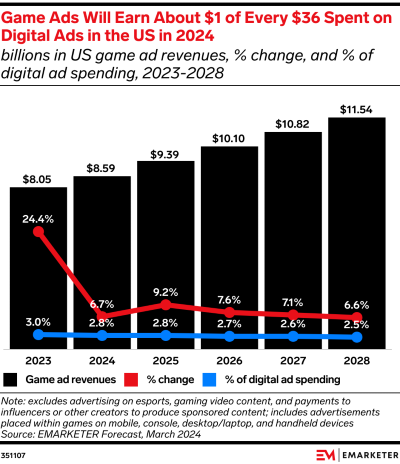The Elevator Test
🛗 Why Your Scroll Depth Is Lying to You, In-Game Ads Get a Clarity Boost as Revenue Rises, and more!

Hey there Smarty 👋
Are you geared up to catch the latest and greatest in quick shorts?
And just a quick heads-up! If you stumbled upon us through a friend, make sure to subscribe here! That way, you’ll never miss out on the trending shorts.

🛗 The Elevator Test: Why Your Scroll Depth Is Lying to You
If your PDP were an elevator ride, would the shopper have everything they need before the top floor?
Most brands say yes. They front-load lifestyle shots, tuck specs into a tab, toss in a video down below, and call it good. But shoppers don’t move linearly. And scroll depth doesn’t mean satisfaction. It just means they stayed in the elevator too long and probably missed their floor.
Scroll loops aren’t engagement. They’re re-decisions.
Imagine someone shopping for a $240 carry-on. They land on the page. Scroll through three visuals. Pause. Go back to check the color picker. Tap the video. Exit. Click “Details.” Revisit Image #2.
It’s not browsing. It’s a silent panic: “Do I have enough to decide?”
That’s the PDP Loop, and it lives inside most high-scroll, low-conversion product pages.
Top marketers don’t trust scroll depth. They trust behavior loops.
The real indicator of friction isn’t how far someone scrolls.
It’s how many times they bounce between elements, galleries, specs, reviews, without advancing.
- If 40% re-click the size chart, your visuals fail to translate fit.
- If the product video is late, your images aren’t answering first.
- If reviews are read before they click “Add to Cart,” that’s a final trust check, too late, and they’re gone.
The best PDPs aren’t prettier. They’re sequenced like stories.
They eliminate doubt before the user has to scroll looking for it.
That’s why gallery data matters more than ever.
Every click is a vote. Votes for what matters. Votes for what’s missing.
And when shoppers scroll back up, what they’re saying is: “You showed me the product. Now show me I won’t regret buying it.”
Eko doesn’t just track what users click. It shows you what they’re searching for, and when.
It reveals scroll loops, timing patterns, and decision drop-offs inside your PDP flow.
You can download the free guide from Eko and start using the data already on your site. Because conversions don’t die at the bottom of the page. They die when your shopper misses their floor, and you never notice.

Together with Codecademy
Get hands-on experience using the latest tools in tech
Get ready for new career opportunities with hands-on learning from Codecademy.
With 600+ interactive courses, Codecademy Pro helps you learn job-ready skills like AI, cybersecurity, and data science.
Learners can also practice for technical interviews, build portfolio-worthy projects, and prepare for top industry certification tests.
Ready to give hands-on learning a try? ScaleUP readers can save 15% on an annual Pro membership when you use code SKILLUP15 at checkout.
Start learning with Codecademy today!

🎮 In-game ads Get a Clarity Boost as Revenue Rises
The IAB just launched a universal Gaming Measurement Framework to standardize how in-game ads are tracked, reported, and valued, bringing clarity to a fast-growing but fragmented channel. This makes campaign reporting more transparent and comparison across partners easier.

The Breakdown:
1. IAB Launches Industry Standard for Gaming Ad Metrics - The new framework outlines how to measure display, video, audio, and custom gaming ads consistently across platforms. It introduces a clear split between must-have metrics (like impressions, CTR, and redemptions) and nice-to-haves (like brand recall, visual tracking, and even neuro data).
2. Game Ads Are Growing, But Losing Share - US game ad revenue will rise from $8.05B in 2023 to $11.54B by 2028, yet its share of total digital ad spend will fall from 3.0% to 2.5%. Growth spikes sharply in 2023 but then plateaus at single digits annually.
3. Mobile Gamers Are Big Spenders and Highly Persuadable - 45% of mobile gamers spend over $200/month on retail, and 60% of Zynga players discovered products through in-game ads. They’re also more likely to shop early, use digital payments, join loyalty programs, and be influenced by holiday campaigns.
Gaming is no longer a niche; 80%+ of US internet users play, and Gen Z/Alpha numbers hit 90%. The IAB’s new framework, combined with spending behavior data from mobile gamers, makes gaming one of the most measurable and retail-aligned ad channels heading into the latter half of 2025.

🚀Quick Hits
🚷 That sketchy link in your inbox? CleanWeb blocks it before you click. Get real-time protection from malware, phishing, and adware, plus a powerful VPN for total privacy. Get it all for just $2.19/month, a limited-time offer!
📋 Meta’s Edits app now lets you save audio, leave sticky notes, mark tasks as done, and filter ideas, making it easier for creators to organize and manage video projects efficiently.
🤖 YouTube is testing “Ask Studio,” an AI assistant in YouTube Studio that analyzes your channel stats, summarizes comments, and suggests ideas.
📊 Google now generates nearly 13% of People Also Ask answers using AI, filling gaps where no clear web source exists.
🧾 93% of Roblox users spend money on the platform, and 52% of them also buy related real-world products. Roblox gamers average 7 hours weekly, and 78% want more off-platform engagement.

That’s a wrap for today! Tell us your thoughts about today's content as we line up more Shorts! And don’t hesitate to share this with someone who’d adore it. 🥰
